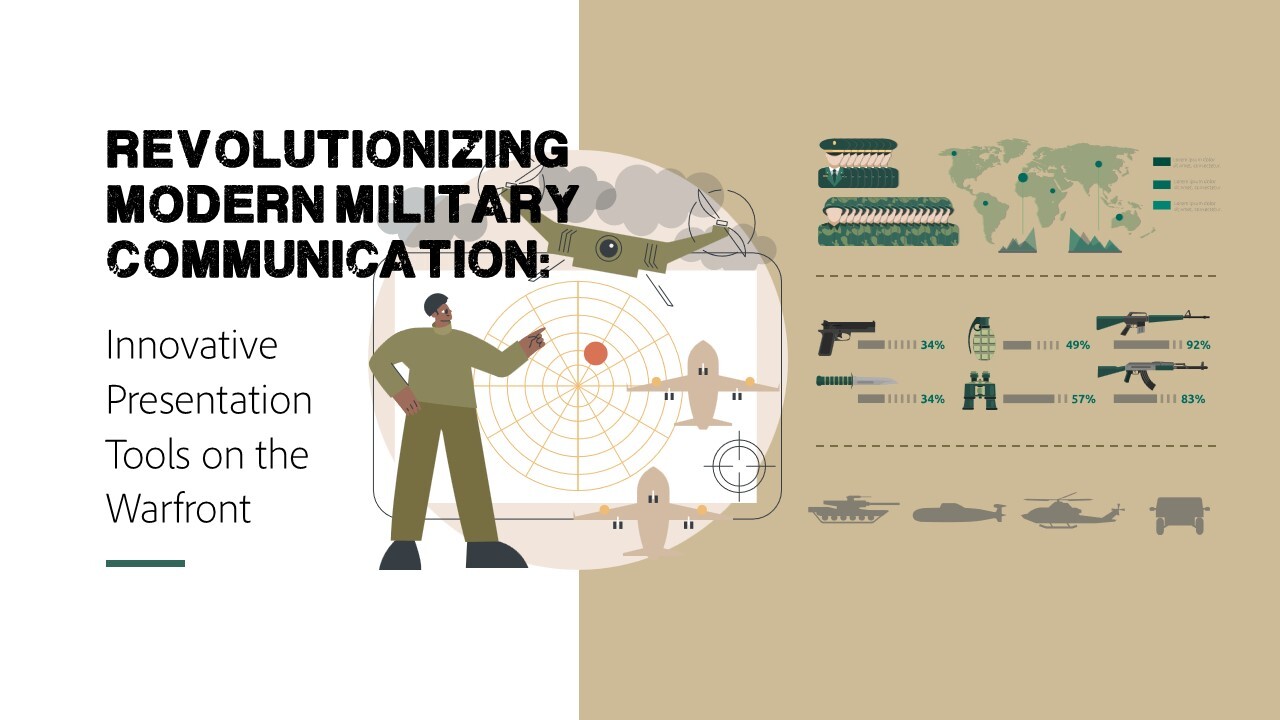Blog
Learn the secrets of ppt making to create compelling presentations.

Learn the secrets of ppt making to create compelling presentations.


Introduction:
When we think about military operations and the war front, the first images that come to mind often involve soldiers in uniform, battle tanks, and the sound of gunfire. However, in the modern age of technology and information, presentations have also become valuable tools for communication and decision-making in the military. This may sound unconventional, but as we’ll explore in this blog, presentations play a crucial role in various military and strategic contexts. Not only do they encompass traditional PowerPoint presentations, but they also extend into the realm of video presentations, virtual reality, 3D visualizations, and the utilization of AI tools.
Briefing and Intelligence Analysis:
At the heart of every military operation is a well-informed plan. Military commanders and leaders are now using presentations to communicate important intelligence, mission objectives, and strategies. Visual aids such as maps, images, charts, and graphs help convey complex information more effectively, ensuring that the team has a clear understanding.
Operational Planning:
Prior to any military mission, planners utilize presentations to outline the mission’s details. This includes troop movements, logistics, timing, and objectives. Presentations play a pivotal role in ensuring that all team members are on the same page and have a comprehensive understanding of the plan.
After-Action Reviews:
In the aftermath of a mission or battle, presentations come in handy for reviewing what went right and what went wrong. These presentations help in identifying lessons learned and areas for improvement, ensuring that successes are built upon and mistakes are not repeated.
Training and Education:
Presentations are not limited to operational use but also extend into military training and education. Soldiers are taught about various topics, from weapons and tactics to strategy. Visual aids and interactive presentations enhance the learning experience.
Public Affairs and Information Operations:
In today’s warfare landscape, it’s essential to communicate with both the military and civilian populations. Presentations are used to convey information to the public, address concerns, and provide updates on military operations’ progress.
Diplomacy and Negotiation:
Military leaders often find themselves at the negotiation table. In these scenarios, presentations assist in conveying key points and negotiating from a position of strength.
Crisis Management:
During crises or emergency situations, military leaders turn to presentations to coordinate responses, update stakeholders, and ensure that everyone is on the same page concerning the situation and the plan to address it.
Logistics and Supply Chain Management:
Optimizing logistics and supply chains is crucial in the military. Presentations are employed to manage and ensure that troops have the necessary resources and support.
Embracing Modern Technology:
While traditional PowerPoint presentations are still commonly used, modern technology has significantly expanded the possibilities. Video presentations, virtual reality simulations, and 3D visualizations offer dynamic ways to present information. Additionally, AI tools have entered the scene, providing data analysis and visualization capabilities that were once considered science fiction.
Conclusion:
The recent declaration of war by Israel on the Palestinian militant group Hamas, prompted by an unprecedented and multifaceted attack, has sent shockwaves through the region. The toll has been nothing short of catastrophic, with over 1200 lives lost in Israel and at least 900 in Gaza, according to reports from the public broadcaster Kan. These heart-wrenching events serve as a stark reminder of the profound human suffering and the intricate challenges that continue to characterize this enduring conflict.
In the face of such devastation and loss, the importance of seeking diplomatic solutions and fostering peaceful dialogue has never been more evident. The value of presentations and communication tools, as highlighted throughout this blog, becomes all the more apparent. In this tumultuous landscape, where lives are lost and communities are torn asunder, presentations have a unique role to play in conveying crucial information, fostering mutual understanding, and serving as bridges towards a more peaceful and stable future.
While the horrors of war are undeniable, the power of communication, through presentations and other means, remains a beacon of hope. It is through these tools that we can aim to mitigate the suffering and seek pathways to resolution, healing, and reconciliation. In the midst of conflict, the importance of effective communication and informed decision-making cannot be understated. The road to peace may be long and arduous, but with the right tools, it is one that humanity must continue to tread in the pursuit of a better, more harmonious future.
In the realm of modern presentations, agencies like SlideCEO are leading the charge, offering visually engaging solutions on a global scale. SlideCEO, a premier presentation design agency, provides a wide range of services tailored to various needs, from business and product presentations to annual reports, video presentations, Virtual Reality presentations, 3D modeling, and prototype designs.
As this blog has highlighted, advancements in presentation technology and the integration of AI tools have revolutionized communication in high-stress environments. In today’s world, the power of effective visual communication cannot be understated, and agencies like SlideCEO play a pivotal role in ensuring that information is not only conveyed but captivates and engages. In the face of complex challenges, they bring us one step closer to resolutions grounded in dialogue, understanding, and, ultimately, peace.